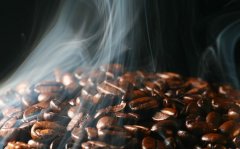Problems of dehydration, climbing temperature, smoke exhaust and taxiing of coffee roaster
When is dehydration? How many degrees does it take to climb? Smoke exhaust problem? What is the taxiing action? These professional knowledge about coffee roasting must be the skills that many coffee roasters want to know, so here is a little experience for coffee lovers: however, it is only a simple introduction. For details, please refer to coffee roasting and other related books or interested coffee lovers are welcome to discuss!

1. Dehydration:
Generally refers to the baking process below 170 degrees. Different baking appliances require different dehydration time, but it is usually best controlled at 5-8 minutes, depending on the water content of the beans.
two。 Climbing temperature:
Usually, the climbing temperature speed of baking is controlled between 7 and 14 degrees, which is related to the control of firepower. The better climbing temperature speed is about 10 degrees. The climbing temperature speed of beans varies with different water content. The temperature climbing speed of hard beans and seasonal beans (with more water content) should be slow to lengthen the dehydration time, while the temperature climbing speed of soft beans or old beans in the coming year (low water content) should be faster and the dehydration time should be shorter to retain the flavor of beans.
3. Smoke exhaust:
The smoke discharge of baked beans begins to be obvious at 180 degrees, the first explosion becomes larger, and the second explosion reaches the maximum, and the deeper the baking smoke is, the bigger the smoke is. At this time, the air door should be fully open to avoid the smoke attachment of baked beans.
4. Taxiing:
This is the place where most baking beginners ask, in fact, the taxiing action is to cool down or turn off the heat to use the temperature of the boiler to continue baking beans.
The beans are endothermic throughout the baking process, only the first explosion-the second explosion is an exothermic action, it is best not to increase the fire baking in these two stages, otherwise the beans are easy to feel spicy. Taxiing emphasizes that the baked beans can be roasted continuously and slowly by using the residual temperature of the boiler and the temperature produced by the heat release of the beans during the burst period. But the taxiing of the hand net, just leave the source of fire, let the beans dissipate heat naturally, do not take too long, if you want to lock the flavor, you have to use the fan to cool down quickly to retain the flavor. Taxiing is not suitable for all beans with all baking degrees. Recently, we have seen a lot of brown friends baking light-baked Yejasuefei gliding down beans, and a single medium-baked Brazilian beans gliding down beans, which is wrong:
Beans before moderate baking (before the second explosion) are usually dropped at any time when the temperature is low, and there is no gliding "drag time" under the beans, which will roast off the flavor of the varieties of beans that should be produced.
On the other hand, the beans after the middle and deep baking degree (after the second explosion), it is suggested that the beans should be cooled or turned off to make use of the stable climbing temperature of the boiler, and there should not be any action of adding fire after this stage (the second explosion). Because the bean is exothermic in the burst stage, the temperature will continue to rise, so there is no external temperature for it, so the taste and flavor of the bean will be softer and less irritating.
5. The beans must be cooled immediately after baking, and the faster the better, so that the flavor of the beans can be locked and the loss can be avoided.
PS. The above are very shallow insights and suggestions for beginners to learn more easily when practicing baking. And the deeper concept of baking has many books to refer to.
The best baking time is 12 ~ 15 minutes, the best flavor, Italian baking less than baked beans for a long time, Europe and the United States quick frying or Japanese slow frying also has its own characteristics and flavor. In addition, when it comes to the problem of oil production of beans, the more fat we drink, the better the taste, while the beans with less oil are thin and boring, but do we have to see oil in roasted beans? This is not the case, and the oil from baked beans is not bad, the most obvious period of oil production during baking falls at 233 degrees Celsius, when it is very easy to produce oil. As long as the fire is not added or turned off and the air door is opened to keep the boiler stable at about 230 degrees, the baked beans can continue to explode until the middle and rear section of the baked beans do not produce oil. if the baked beans are not properly controlled to cause too high temperature, the baked beans will produce a lot of oil. then drink it as soon as possible in a few days to avoid excessive oxidation into "oil shit smell".
Important Notice :
前街咖啡 FrontStreet Coffee has moved to new addredd:
FrontStreet Coffee Address: 315,Donghua East Road,GuangZhou
Tel:020 38364473
- Prev

General knowledge of coffee roasting roasting and roasting degree of coffee beans
Roasting causes coffee to produce coffee oil, which gives coffee a strong aroma. The most outstanding feature of this fragrance is that it is volatile and soluble in water. Therefore, people can not only smell the mellow smell of coffee beans, but also pour it into the cup and taste it carefully. Coffee is roasted to the following degrees: light roasting, light fragrance and high acidity is one of it.
- Next

Coffee roasting is the process of awakening the strongest aroma in the world.
Grab a handful of coffee raw beans smell, there is always a pungent smell, very different from the impression of the charming smell of coffee. However, after roasting "fragrance" correctly, raw beans will emit the strongest aroma in the world. The small high-altitude Arabica coffee raw beans are like a warehouse full of chemicals. At present, scientists have identified more than 2,000 known ingredients, including 700 to 700.
Related
- Beginners will see the "Coffee pull flower" guide!
- What is the difference between ice blog purified milk and ordinary milk coffee?
- Why is the Philippines the largest producer of crops in Liberia?
- For coffee extraction, should the fine powder be retained?
- How does extracted espresso fill pressed powder? How much strength does it take to press the powder?
- How to make jasmine cold extract coffee? Is the jasmine + latte good?
- Will this little toy really make the coffee taste better? How does Lily Drip affect coffee extraction?
- Will the action of slapping the filter cup also affect coffee extraction?
- What's the difference between powder-to-water ratio and powder-to-liquid ratio?
- What is the Ethiopian local species? What does it have to do with Heirloom native species?

